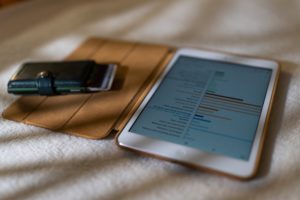Paying with a checking account has become increasingly popular and convenient in today’s fast-paced world. With the rise of digital banking and the widespread use of payment apps, checking accounts offer you more flexibility and control over your money than ever before. Read online to explore the benefits and various methods of paying with a checking account.
What is a Checking Account and How Does It Work?
Checking accounts are offered by traditional banks, online banks and credit unions. They allow you to deposit and withdraw money for everyday expenses, including bill payments and everyday purchases.
When you open a checking account, you will receive a debit card and checkbook to access your money. With your debit card, you can make in-store and online purchases and withdraw cash from ATMs. You can also write paper checks for various purposes, including paying bills, making purchases or giving money as a gift.
A key benefit of having a checking account is the ability to manage your money conveniently and securely. Most banks offer online banking services, which enable you to view your account balances and transaction history and set up bill payments. Some banks also provide mobile banking apps that allow you to manage your account, schedule bill payments, make cross-account transfers and even deposit checks using your smartphone.
There are different types of checking accounts to choose from, each with varying features and fees. Some accounts may have no monthly maintenance fees, while others may require a minimum balance to avoid fees. Some banks offer interest-bearing checking accounts, allowing you to earn interest on your account balance. When choosing a checking account, it is important to compare options and find one that meets your financial needs.
Before opening a checking account, remember to review the terms and conditions to ensure you understand any fees and limitations associated with your account. By doing so, you can make the most of your checking account and effectively manage your money.
Shopping Online and Paying with a Checking Account
Shopping online has become incredibly convenient. Consequently, many people use their credit or debit cards to complete transactions. However, it’s possible to shop online and pay with a checking account, giving you more flexibility and options when making purchases.
One popular method to pay with your checking account is by using PayPal. When you link your checking account to your PayPal account, you can make payments online without having to enter your debit card information. Simply select PayPal as your payment option during checkout and use your checking account as the source of funds.
Another option for shopping online with a checking account is using an e-check or electronic check. An e-check is an electronic version of a paper check that works the same way but digitally. To pay with an e-check, you’ll need your bank’s routing number and your account number. Some online stores accept e-checks for payment, allowing you to complete your transactions without a debit card.
Some online retailers, such as Amazon, have made it possible for customers to add their checking accounts as a direct payment option. By entering your bank’s routing number and your account number, you can assign your checking account as a payment method and use it during checkout. The process is similar to using a debit card, but it draws funds directly from your checking account.
The Advantages of Using a Checking Account To Shop Online
Here’s a closer look at the key benefits of using a checking account to make online purchases.
Flexible Access
By using a checking account to shop online, you can enjoy a variety of payment options to access your funds. This includes the ability to pay with your debit card or e-check. With this added flexibility, you can make purchases from various online retailers. Furthermore, you can enjoy a seamless and convenient shopping experience.
Track and Monitor Your Purchases
Another benefit of using a checking account for online shopping is the ease of tracking and monitoring your purchases. Most banks and financial institutions offer online and mobile access to your checking account transactions. So, you can get real-time updates as you initiate transactions and monitor your spending habits. This can help you stay organized and make informed financial decisions.
Establish Credit
Using a checking account responsibly can also indirectly help you establish and maintain solid credit health. Regularly checking your account, paying bills on time and managing your spending can positively impact your credit score and financial history, making it easier to qualify for debt products in the future.
Streamlined Financial Management
Checking accounts offers the advantage of consolidating your financial activity in one place, which simplifies your financial management. With access to your account balances, transaction history, and bill payments all in one place, you can manage your finances and budgeting efforts with ease.
Safety and Security Measures
When you shop online with a checking account, you benefit from the safety and security measures provided by your bank, credit union or financial institution. These services often include fraud detection, account alerts, and the ability to freeze your debit card if it’s lost or stolen. Some financial institutions also contact account holders to verify unusual account activity and, depending on the response, take action accordingly to protect your hard-earned money. By taking advantage of these security features, you can confidently shop online and protect your personal information.
How To Shop Online and Pay with A Checking Account
Shopping online doesn’t always require a credit card. You can use your checking account to make payments for online purchases, too. Below is a closer look at how to move forward:
Using an Electronic Check (e-Check)
As mentioned above, an electronic check, or e-check, is a digital version of a traditional paper check. To pay with an e-check, you’ll need your bank’s routing number and your checking account number. Many online retailers and service providers accept e-checks as a payment option. Here’s a breakdown of how to use an e-check:
- Choose the e-check option during the checkout process
- Enter your routing and checking account number
- Confirm the transaction
- Complete the payment
Remember that e-check transactions may take a few days to process, so be patient when using this method.
Mobile Money Management and Check Payments
You can also use your banking app to make online purchases by linking your checking account or debit card to the app. Many banks offer their own mobile payment solutions or partner with popular payment apps like Zelle or Venmo. To set up this payment method:
- Download your bank’s app or a third-party payment app
- Link your checking account or debit card to the app
- Choose the app as your payment method when making online purchases
- Confirm the transaction and your payment will be completed
Other Forms of Checking Account Payments (Apple Pay, PayPal, etc.)
Several alternative payment options allow you to use your checking account for online purchases. For example, Apple Pay and PayPal offer the ability to link your checking account or debit card to their platforms to make payments. Here’s how to use these payment options.
- Create an account with the payment service (e.g., Apple Pay or PayPal)
- Link your checking account or debit card to the service
- Choose the service as your payment method when making online purchases
- Confirm the transaction
- Complete the payment
Comparing Different Online Shopping Payment Methods
Now that you’re aware of the various ways to make check payments, here’s a look at the differences between your options.
Checking Account Payments vs. Electronic Check (e-Check)
Both options allow you to pay directly from your checking account; they each have their unique attributes.
Checking account payments usually requires you to provide your bank account and routing numbers, with the transaction completed quickly and securely. Some online retailers like Amazon accept checking account payments, making it convenient for those without a credit card.
On the other hand, e-checks function similarly to traditional paper checks, involving a longer processing time. You’ll need to input your account and routing numbers, as well as your check number and the payment amount. e-checks offer an alternative for shoppers without access to cards or digital wallets, with platforms like PayPal supporting e-check payments.
Checking Account Payments vs. Credit Cards
Credit cards remain a popular choice for online shopping due to their convenience and security features. When using a credit card, you can benefit from various rewards programs, purchase protection, and the ability to dispute fraudulent charges. However, resorting to credit cards can also lead to overspending. And you can potentially accrue several hundreds or thousands of dollars in interest on outstanding balances.
By contrast, checking account payments come straight from your bank account, reducing the risk of overspending and incurring debt. It generally offers fewer security measures than credit cards but can be a suitable choice for budget-conscious shoppers.
Checking Account Payments vs. Digital Wallets
Digital wallets, like Google Pay or Samsung Pay, store your payment information securely and allow for quick transactions without needing to input your card or bank account details each time. Digital wallets provide extra layers of security with encryption and biometric authentication. They work with various payment methods, including credit cards, debit cards, and sometimes even checking accounts.
The key differences between checking account payments and digital wallets are convenience and security. Although checking account payments are relatively simple, digital wallets streamline the shopping process even more with added features like contactless payments and rewards.
Checking Account Payments vs. Apple Pay/PayPal
Apple Pay and PayPal are two popular digital wallets offering unique features and benefits. Apple Pay provides seamless payments through iPhones, iPads or Apple Watches, using biometric authentication and tokenization for secure transactions. However, it is limited to Apple devices, and not all online retailers accept Apple Pay.
PayPal operates as both a digital wallet and a standalone payment method, allowing for flexible payment options, including checking account payments, e-checks and credit cards. PayPal is widely accepted by online retailers and offers strong fraud prevention measures to protect your sensitive information. Keep in mind that transaction fees may apply with certain PayPal services.
The Best Way To Shop Online and Pay with A Checking Account
When shopping online, it’s essential to find a secure and convenient method of payment. One of the best ways to do this is to use your checking account. Here are the two most popular methods of paying with a checking account.
Linking a Debit Card
A straightforward and widely accepted approach to pay with your checking account is by linking a debit card. By associating your debit card with the account, you can enjoy a smooth online shopping experience. Here’s how to do it:
- Ensure that your debit card is enabled for online transactions. You can usually check this through your bank’s app or website.
- During the checkout process for an online store, choose the debit card payment option.
- Enter your card number, expiration date, and CVV code, and then proceed with the transaction.
Using a debit card is quick and convenient, allowing you to complete your purchase without additional fees. It also offers a higher level of security by using multi-step authentication processes to safeguard your transactions.
Setting Up Direct Debit Payments
An alternative method for paying with your checking account is to set up direct debit payments. This process involves providing your account and routing numbers to the online store and authorizing them to withdraw funds directly from your account. Here’s a step-by-step breakdown of how to set up direct debit payments:
- During the checkout process, select the direct debit or bank transfer option.
- Provide the necessary information, including your bank account number and routing number.
- Confirm the transaction details
- Authorize the payment.
By setting up direct debit payments, you can keep a closer eye on your finances, as transactions will reflect directly in your checking account. This method might also help you avoid potential fees associated with other payment methods.
How to Choose a Checking Account for Payments
Individuals, families and small business owners can choose from many checking accounts. You should check if the company is a Member FDIC. You should immediately ignore any financial institution, credit union, or online bank that doesn’t have this designation. These are some of the things to keep in mind before working with a company that offers banking services in the United States or elsewhere.
Consideration of Fees
It’s a good idea to review fees before selecting a personal bank account. Overdraft fees and monthly maintenance fees are two of the most common expenses. Some banks have removed these fees or reduced them. Consumers should also look at the fees for various financial products.
Understanding the Account’s Terms and Conditions
Check the account’s terms and conditions to see the rules and consequences for breaking them. Most banks are straightforward, and reviewing the terms and conditions will be a basic refresher for informational purposes. However, some banks may have less favorable terms and conditions, such as limiting how many transactions you can make each month before incurring fees or a low APY.
Look at the Account’s Services and Features
Most banks offer more than checking accounts. They also offer savings accounts, business bank accounts, and joint checking accounts. A major problem with many checking accounts is a low APY, but savings accounts offer higher APYs.
Most banks offer more than just those resources. In fact, you might also be able to get a credit card or a loan from the bank. It’s good to look at each feature within the checking account, such as budgeting tools, APY, direct deposit, and others. It’s also a good idea to see if you can use a different payment method automatically to prevent you from overdrawing your account.
The bank may also offer a special perk for first-time users, such as a sign-on bonus. If you are a customer for a sufficient amount of time, you might even get a discount on loans and credit cards.
Consumers should consider whether they want to visit a bank branch or do everything online. While firms like Bank of America and Barclays offer physical branches, online banks usually offer better interest rates and fewer fees since they have less overhead. A top-notch customer service team can also make the decision easier.
Conclusion: Best Practices for Paying with a Checking Account
Using your checking account for online payments offers convenience, security and financial control. By linking a debit card or setting up direct debit payments, you can make your online shopping experience hassle-free.
When comparing various payment methods for online shopping, consider your comfort level with the technology, the security features, and the availability of the method with your preferred retailers. Ultimately, the choice of payment method should align with your financial goals and unique shopping preferences.







